Coyote Waits
A sleepy-eyed early-morning riser retrieving the morning paper in her bathrobe stands bow-legged, slack-mouth stunned.
A driver of a Toyota van brakes abruptly to a stop — blocking an intersection.
Ignoring my 7 a.m. walk through central Irvine, the group lopes down the middle of the street (one with a sideways glance). In close formation, their tongues dangling, they pass the community clubhouse, the pool, the tennis courts and the daycare center. Then without hesitation, turning right, they pick up speed across a greenbelt toward agricultural lands and Peters Canyon Wash, through the flood control channel under the Santa Ana Freeway (cars moaning like Gabrieleno tribal drums overhead), past the asphalt fields of Tustin Market Place, cutting north to the hills — a gang of six.
Somewhere amid the snooze alarms of Irvine's earth-toned homes, breakfast has been served.
—
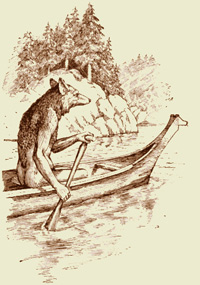
Coyote is here . . . and he is one of us. A suburban survivor crafty enough to find his place in our maze of industrial parks, freeways and housing tracts. A seeker poking his way through a forest of human device. A resilient creature. A mangy myth.
Known as the howling silhouette, the loner, the song dog, the First Creator, the Old Man, The Trickster, the Transformer, the Gambler, Imitator and Demi-God, Coyote is both a hero and villain. In Native American legend, western folklore and new age mythology he is omnipresent. Here, in what we call civilization, he finds home on the grid.
The coyote of legend is a male figure and, like the suburban world, a complex paradox. Knowledgeable, greedy, wanton, callow, and intuitively wise in spite of himself, Coyote is blamed and praised for originating death, chaos and uncertainty, creating the world, jumbling the stars, fornicating with birds, losing the sun, and discovering tobacco.
Coyote frees all the world's animals from inside the mythological monster's stomach. He tells women that, unless they become his wife, they will die. He juggles his eyes to see the horizon.
He's the owner of that black BMW who lets you merge into traffic and then cuts you off at the next light. The leader of the congregation caught fooling around. The councilmember who woos the voters and then sells the city to developers.
He looks back on the Garden of Eden both bewildered and cocksure — a beggar, thief, comedian, crooner, hunter, ragpicker, hustler, dealmaker, shithead and prophet.
“A forerunner of the savior and like him, God, man and superman alike,” wrote Carl Jung. Coyote is “both subhuman and superhuman, a bestial and divine being.”
Sniffing the garbage and staying out of sight — a nervous animal, almost invisible in our flat landscape — Coyote emerges dodging through traffic, eating our pets, and disrupting our planned communities and lives. Like our world-on-the-make, he is playfully disingenuous — an Antonio Bandaras wannabe on all fours with a tail, nosing around the bar at Twin Palms, Woody's Wharf, and the Cannery.
What is sacred? Can we cut a deal? Who's your god? Wanna fuck? Coyote seeks out dogma, principle, decorum, faith and certainty — then lifts his leg.
—
Coyote is the common name for Canis latrans — literally “barking dog” — originally from the Nahuatl word “Coyotyl.” (Nahuatl is one the many native peoples and languages that Europeans dubbed “Aztec.”)
You can pronounce it “ki-o-tee,” as do most city folk. Or you can pronounce it “ki-oat,” as do the romantics who live (in spirit or flesh) in the sunset of the old west. But to be spot-on, and do right by the Nahuatl, say “coy-yo-tay.”
There are 19 “subspecies” (or “races” depending on your biological preference) of Canis latrans spread across North America, all of them admired by Native Americans. European settlers, however, admired Coyote more as a pair of potential earmuffs or a warm furry overcoat than a biological stratum or creature of myth. And so early on, white hunters assigned him a mistaken identity — Coyote was assumed to be a type of wolf.
He became “Prairie Wolf” in the Midwest, “Brush Wolf” in Saskatchewan and “Cased Wolf” by trappers in the Southwest who would peel off his hide without fully slitting the skin — like a cased sausage.
Coyote is all points — raised arrow-shaped ears, extended tapering snout, fixed angled eyes, sharp fangs and long stilt legs — all attached to a lanky body with a thick double coat of hair.
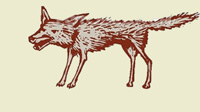 One coat — the dark guard hairs — protects him from the weather. A thick undercoat provides insulation. Its color varies from the reddish-blond of arid-zone coyotes to darker gray on coyotes of northern forests. A black-tipped tail points down to the ground at a 45 degree angle when he prowls, accentuating, as Mark Twain noted, “a general slinking expression all over.” One coat — the dark guard hairs — protects him from the weather. A thick undercoat provides insulation. Its color varies from the reddish-blond of arid-zone coyotes to darker gray on coyotes of northern forests. A black-tipped tail points down to the ground at a 45 degree angle when he prowls, accentuating, as Mark Twain noted, “a general slinking expression all over.”
Full grown coyotes range in size from 38 to 53 inches in length (tail included). The smallest — Canis latrans microdon — is found in the lower Rio Grande and can weigh as little as 18 pounds. Mountain coyotes, like those found in the Sierra Nevada north of Orange County, can top the scales at 75 pounds.
Coyote's gift is his adaptability. With a relatively large brain, and exceptional sense of smell, sight and hearing, some lovers of the wild have called him “the smartest animal in North America.”
“They're not as smart as pigs,” says Bob Ferris, Director of Species Conservation at Defenders of Wildlife in Washington, D.C. “Their intelligence is in their flexibility, and that comes from not being a specialist. For example, they'll eat nearly anything.”
Coyote's menu includes birds, large insects, rodents, small house pets, roadkill, grapes, dates, carrots, pumpkins, watermelons, beavers, snakes, ants, human and coyote carcasses, frogs, peanuts, leather, tires and the occasional garden hose. He is an animal that would be just as content wolfing fries at Charlie's Chile as he would be sampling hors d'oeuvres on the Orange Hill Restaurant patio.
“They're a crepuscular animal,” Ferris says. “Which means they're most active at dawn or in the evening. It's the cooler time of day and it's when coyotes can take best advantage of rodents and other small animals.”
Barbara Walters takes the cue from ABC's 20/20 announcer and looks into the camera disquietingly concerned and TV-friendly. Reading a prompt, the often-imitated, never-equaled enunciator of news begins.
“It does seem as if nature has it in for Californians. They face so many threats from nature — fires and floods and earthquakes — and now another one lurks: coyotes, hungry coyotes who are invading residential streets and backyards in search of food, putting family pets and even small children in jeopardy.”
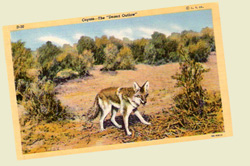 Tom Jarriel, on remote from Southern California, beams in. “The ability to survive and endure has put man and coyote increasingly face to face. As the barriers between the two become blurred with the coyote's natural habitat culled into the neat streets of suburbia, the coyote has become an unwelcome neighbor.” Tom Jarriel, on remote from Southern California, beams in. “The ability to survive and endure has put man and coyote increasingly face to face. As the barriers between the two become blurred with the coyote's natural habitat culled into the neat streets of suburbia, the coyote has become an unwelcome neighbor.”
Neighbor? No one asked Coyote to be a neighbor. Pushed back by land development and detested by sheep ranchers, goat herders and cattle ranchers, and for what? All Coyote ever wanted was a piece of the action.
And now, in the pedicured and pedigreed neighborhoods that replaced his primitive home, Coyote is a nemesis — a devil dog to the owners of small pets.
—
Coyote looks down on the Laguna Niguel development of San Marin. It's a community rich with domestic cats and dogs. Bowls of Iams, Science Diet and Sheba sit outside patio doors (just waiting for a hungry coyote).
As the rich get richer, their dogs get smaller. No slobbering Irish Setters live at San Marin. Instead, the pooches are bite-sized and their owners' attitudes toward nature perverse. Here, the community association hires exterminators to poison rabbits for the crime of eating pansies and gazanias (guilty of spoiling the uncompromising landscape architecture of discriminating homeowners). It's also a neighborhood where, at times, community meetings focus on the crisis of lawn spots created by dogs who, when out for an evening stroll with their owners, have the audacity to piss on lawns.
“Live in a man's house, pee in his toilet.” Coyote laughs.
Nearby, in a multi-level, post-California-renaissance fern garden backyard, underneath a custom faux-Roman gazebo, dinner awaits Coyote in the form of a dachshund.
“Better than chasing a rabbit around for half an hour,” he thinks.
Coyote stalks quietly, eyes locked on his future meal. Over the wrought iron gate, low to the ground through azalea and fern, then behind a queen palm, he waits for his moment. It arrives in a burst. With three quick steps Coyote is close enough to sink his teeth into the dachshund's neck. The dog lets out a yelp.
“Shit,” thinks Coyote. He clamps down harder, but by then the screen door has opened and the owners are upon him.
“Danny,” they shriek to the gasping dog. With rakes, broom handles and a vigor reserved for the protection of offspring, the humans beat Coyote into retreat. He escapes over a five-foot fence down a steep embankment and zips across Crown Valley Parkway. Properly inspired and in his prime, he can reach speeds of more than 40 miles per hour.
Later that night Coyote spots a Yorkie who's sniffing for cats outside while his owner sleeps in front of a blaring TV in the den.
“Probably watching Barbara Walters,” Coyote thinks.
The kill is silent.
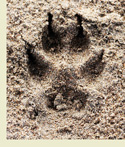 Coyote attacks the throat just behind the jaw and ear, clamping down on the meal's windpipe. A small coyote can kill a large sheep or calf with nary a sound. With your throat shut, it's hard to squeal. Coyote attacks the throat just behind the jaw and ear, clamping down on the meal's windpipe. A small coyote can kill a large sheep or calf with nary a sound. With your throat shut, it's hard to squeal.
Usually, Coyote will drag his meal to a quiet area, make an almost surgical opening in the thorax and consume the heart, lungs, liver and internal organs. It is a rare occasion when he will pick at the bones or haunches.
The next morning at San Marin, gardeners find, in a clump of African daisies, a headless furry body lying on its back — insides picked clean, rib cage broken in the relish of the feast.
Funeral preparations begin.
—
Coyote has been roaming the Southern California hills since the early ice ages. Scores of his well-preserved skulls in the muck of Los Angeles' La Brea Tar Pits attest to that. Back then his western home stretched from central Mexico to Southern Canada. After the mid-19th century he migrated, east to New York and New England, north to Alaska, and south to Panama. By the late 1970s, Coyote arrived at the Atlantic seaboard, taking up residence just about anywhere, including Central Park and the Bronx's Woodlawn Cemetery. During a particularly cold winter in 1987, a pack managed to hop aboard an ice floe and cross the sea from Cape Breton Island in Nova Scotia to Newfoundland — a 12-hour ferry ride away.
Coyote now breeds there successfully.
Some biologists dispute that Coyote migrated east (jealous of our western icon, I suspect). They claim that eastern coyotes are natives that reemerged from remote wilderness areas after reforestation. Others say that the east coast coyote arose from traveling western coyotes, who interbred with small wolves and produced a larger eastern subspecies.
One thing is certain — man helped Coyote dominate the terrain. Across the continent, hunters were popping off their shotguns in an orgy of wolf kills (real wolves, not prairie wolves). An ecological niche for a mid-sized predator opened up — and Coyote was just the punk to fill it. Later, sheep farmers in the western plains moving their herds to eastern marketplaces, or to pastures in the south, provided coyote with a traveling lamb picnic — all the way to Central America. He followed settlers' pack trains and mule teams to feed off the carcasses of dead or dying beasts of burden. And he followed miners as they laid a trail of garbage and scraps of food from California to Alaska, opening up a coyote highway to the north.
—
In the PBS-emboldened intellectual world of Joseph Campbell, Bill Moyers and Hugh Hewitt — where religion and spirituality are soft pedaled and divided like categories at a CD store (Acid Zen, Techno-Christian, Pop-Buddhist, Alternative) — Coyote has been stocked in a holy bin as the mythological Trickster.
The Trickster works magic through subversion and confusion — in a surrealistic state — until a lesson is learned and wisdom gained. In moving from one disaster to the next, he executes metaphysical pratfalls to teach us why laughing at our follies is the gateway to nirvana.
But according to Paul Apodaca, professor of sociology at Chapman University and Curator of Native American Art at Bowers Museum in Santa Ana, “Coyote as Trickster” is an understanding of convenience. It is an easy explanation that helps the PBS crowd categorize Coyote. In Navajo tales from the Southwest, Apodaca says, Coyote's meaning is far more significant. Navajo legend identifies Coyote as Atse Hashke or “first scolder,” a character of disharmony. “Which is interesting,” Apodaca says, “because the Navajo word for cosmos means beauty or symmetry. In the midst of harmony then, there is the disharmonious.” There is Coyote.
“Centuries before our theories of chaos, the Navajo recognized an element of the unpredictable in nature,” Apodaca says. “Even if we do everything right, wrong things happen. Coyote is the embodiment of that, which is markedly different than a trickster.”
“Coyote as Trickster,” according to Apodaca, is the European understanding of spirituality overlaid on the Southwest Native American. Convenient, yes. Accurate, no.
When Native Americans were the only inhabitants of our continent, the animal population was enormous. Through the pragmatism of being outnumbered, the human population in prehistoric times learned humility. Humans may have been, as Apodaca put it, “the weakest child in nature.”
Trying to fit into nature's family did not necessarily mean you were filled with spirituality; it only meant that you had good common sense. And amid that common sense and symmetry was Coyote, not the Trickster, but the living embodiment of chaos.
—
To the Southern Californian native people, however, Coyote was not the Southwest Region god of anti-symmetry. Somehow, in our Mediterranean coastal flatlands, he became more down-to-earth.
Here, Coyote distinguished himself as a powerfully sexual creature, daring to a fault — a legend based, possibly, on his getting buck-wild with hunting dogs the SoCal natives used for driving deer down from the hillsides of Tustin and Orange. In spite of this less-distinguished status, however, Coyote does play a savage role in one of the archetypal myths of Southern California Native culture. In it, the creator of human life becomes unbearable, and in due course, is murdered with planetary consensus. A funeral is held. Coyote appears, rips out a piece of flesh from the creator's carcass and holds it up triumphantly to the mourners (who happen to be having a great time).
What does Coyote's action mean? Apodaca says it's anyone's guess. What we do know about Coyote's behavior is that by the 1700s, he was tearing plenty of flesh from a sacred animal of a different kind — the cow.
The Spaniards — who ripped off Orange County's land from its native people — were not keen on hunting. Yet building missions, spreading the word of the Pope and converting (and whipping) the Native American population wasn't their only business. They turned a handsome profit in the tallow-and-hide trade. Brown-robed businessmen slaughtered cattle by the thousands to keep the missions in the black. But in California's pre-In 'N Out/Big Mac era, beef was mostly an unwanted by-product. So areas around the Missions, including San Juan Capistrano, were unrefined quarter-pounder dumping grounds, strewn with tons of rotting meat. It was a heaven for coyote — a Catholic roadside steakhouse.
—
When Northern European farmers, cattle ranchers and sheepherders settled Orange County in the 19th century, Coyote's role changed. The Indian myth became the “unwelcome neighbor.”
Since Coyote does not hunt in packs (grouping together for combined strength in pulling down larger animals), a living and breathing full-grown cow doesn't serve much of a culinary use for him. But he can wait while a cow gives birth and then dine on a bewildered newborn while its exhausted mother stands by defenseless.
“Coyote especially goes for livestock in the late spring and summer, when pups are hungry and too young to hunt,” Bob Ferris says. “The mother coyote will do whatever she needs to bring them food. If the supply of her usual food — rodents and other small mammals — is scarce, the coyote will go for lambs, sheep and goats. Livestock is easy food.”
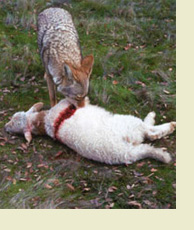 Dining on newborn calves and little lambs, Coyote gained a notorious reputation as a cold-hearted killer — even though livestock makes up only 14 percent of his diet. These statistics, of course, weren't yet available to early livestock entrepreneurs (not that they would have mattered), and so Coyote's behavior just pissed them off. Dining on newborn calves and little lambs, Coyote gained a notorious reputation as a cold-hearted killer — even though livestock makes up only 14 percent of his diet. These statistics, of course, weren't yet available to early livestock entrepreneurs (not that they would have mattered), and so Coyote's behavior just pissed them off.
In the spirit of the Wild West, Coyote was shot, trapped, poisoned with strychnine, “denned” (a Vietnam War-style assault which involves pouring gas into the tunnel of Coyote's den and capping it with a match), and even dynamited. Eventually Compound 1080 (a 1940s wartime chemical that speeds up the nervous system so violently the animal meths out and dies in 6 hours) was used against him.
Coyote was fired on from U.S. Department of Interior helicopters. He was shot in the mouth by cyanide guns buried in the ground and triggered when an animal snouted a bait (sometimes consisting of horse brains, armadillo meat, tincture of beaver castor and a musk culled from between the toes of Siberian deer). But with an extremely flexible breeding system, Coyote took whatever we dished out and survived.
“Coyote's litter size adjusts to the amount of food available,” Ferris says. “When coyotes are not hunted, the population reaches the carrying capacity of its terrain and litter sizes are small — an average size of four. But where coyote is hunted, the survivors have more to divvy up, and they have larger litters — an average of up to nine.”
A Fish and Wildlife Service computer model of reproduction revealed that you can shoot, trap or poison 70 percent of the Coyote population in a given area but still fail to reduce the number that will breed the following year.
“What's a reasonable way to control coyote?” Ferris asked himself.
“A blanket approach is a waste of time and resources.”
Smart enough to learn the precise range of a particular farmer's rifle and stay beyond it, Coyote earned the reputation of the outlaw of Orange County's animal kingdom — sometimes even that of a serial killer. There are reports of Coyote killing sprees with uneaten carcasses left behind — a single devil dog at work. But according to Dr. Richard Evans, Chief of Veterinary Services at the Orange County Health Care Agency, these reports don't reveal the whole picture.
“Coyotes kill for their families,” Evans says. “So, they may leave a carcass behind, intending to come back for more later. People find the bodies of their pets cut in two and assume its some satanic cult that did it. But Coyote can bite a cat in two, eat the intestines, have his fill and then leave. They only kill what they can eat.”
—
In 1981, on a hot August morning, 3-year-old Kelly Keen wandered out of her home in Glendale, California. Across the front yard and sidewalk she skipped, plopping down on her residential neighborhood's curb, waiting to be taken to swimming lessons. Ten minutes later, her father came looking for her. He found only her rubber sandals.
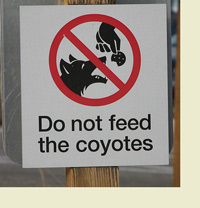 Robert Keen looked around. Off in the brush nearby he spotted a doglike animal moving away. In its jaws the animal was holding a tiny girl by the neck. Keen frantically chased the animal, which fled, dropping its prey. Four hours later his daughter Kelly died of a broken neck and severe internal injuries. It was the first death in the United States ever attributed to a coyote attack. Robert Keen looked around. Off in the brush nearby he spotted a doglike animal moving away. In its jaws the animal was holding a tiny girl by the neck. Keen frantically chased the animal, which fled, dropping its prey. Four hours later his daughter Kelly died of a broken neck and severe internal injuries. It was the first death in the United States ever attributed to a coyote attack.
Keen's neighbors had left food out at night for coyotes who, in turn, enjoyed the hospitality. But one wild dog lost his cool. Now, Coyote was national news.
The Los Angeles Times screeched, “Humans as Prey.” Letters to the editor compared coyotes to Nazis. Burbank's chief of police went before his city council asking for permission to shoot coyotes on sight. And pity the poor humans who stood up for Coyote. They received bomb threats.
Yet, compared to being attacked by your own species or being bitten by a pet, coyote attacks are nearly nil. “Usually the injury occurs with an animal who's been hurt and is approached by someone inexperienced,” Dr. Evans said. “In contrast, last year there were 5,000 reported domestic animal attacks. In the same period of time we had one reported Coyote bite. My advice is, don't feed coyotes.”
—
Coyote saw the bulldozer coming and danced away to the hills.
“No potential dinner could survive that metal beast,” he thought.
Months passed and his home was transformed into a square, sterile landscape.
Coyote's howl pierces the backcountry skies with at least eleven forms of vocalization — including the huff, the growl, the bark-howl, the yelp, two kinds of whine and something called the “wow-oo-wow” (a form of greeting).
After the bulldozer left, construction workers arrived. With their concrete, pipes and lumber — and their Burger King, El Polo Loco, and Taco Bell lunches — they converted the landscape. Responding to the trumpet call of the catering truck, Coyote gathered for a simple group howl.
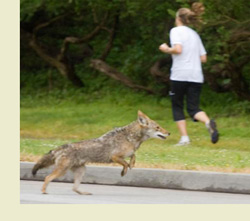 Soon he was hunting for gophers in golf courses, mice in ballfields, rodents in waterways, rabbits in parks, and pets in front of single-family detached units. No more grizzly bears or saber-toothed tigers or irate farmers prowled around coyote's home. Swaggering though the suburbs, taking shelter in drainpipes and abandoned buildings, using waterways and the adjacent land for transportation corridors, Coyote waited. Soon he was hunting for gophers in golf courses, mice in ballfields, rodents in waterways, rabbits in parks, and pets in front of single-family detached units. No more grizzly bears or saber-toothed tigers or irate farmers prowled around coyote's home. Swaggering though the suburbs, taking shelter in drainpipes and abandoned buildings, using waterways and the adjacent land for transportation corridors, Coyote waited.
At night he dug under fences where, that day, new homeowners sweated digging fence postholes. In man-made lakes he dog-paddled around fences that ended in deep water, then played with sticks or discarded pop cans, sometimes inviting a human or a pet dog into the game.
“Not bad,” said Coyote, tilting his head back and howling.
He was being treated fairly enough. Gone were the days of poison. The Nixon administration outlawed its use on public lands in 1972. And although his social standing was still, as novelist William Ashworth said, “right in the center of the innermost ring of hell,” at least Coyote wouldn't pull on a choice meal and get a mouthful of cyanide.
Laurie DeMars, Program Coordinator at the Irvine Animal Shelter, uses a Have-A-Heart trap to catch coyotes that are posing problems in Irvine villages. It's a large coyote-sized cage that's triggered to close when the animal in question is tempted inside. “The coyote's bait is usually a large Zacky Farm chicken, uncooked,” she tells me.
“Times have changed,” Coyote thinks.
—
Will was jogging near UCI when he felt a rush of air against his legs. Figuring he was nearly sideswiped by a car, he turned, ready to hurl an insult. Instead, he looked into the eyes of Coyote. Cool, unamused, in another world, Coyote made a sharp turn and darted into traffic — finding the only path of safety through a puzzle of cars. Half a step back into his jog Will's attention was broken again, this time by the sound of toenails scratching on concrete. Close behind, a second coyote was putting on the brakes. No hesitation, the same turn, the same path into the foothills — faster than any animals Will had ever seen — two gray streaks of ethereal aboriginal power.
—
The myth says that Orange County is the land of plenty. The myth says that our natural resources will be preserved and that the balance between nature, humans, and their god is sacred. The myth says that our resources are inexhaustible. It is the myth of the eternal and the infinite. It is believed to be the challenge — “All things are possible and can be achieved.” Coyote knows better . . . and waits.
He is the opportunist, because he knows there is only so much to go around. He is chaos, because he knows that symmetry needs an opposite. He struggles against confinement because, like us, in that struggle he finds his strength.
At Irvine Park in the foothills of Orange sit two Coyotes in a cage, looking more out of place than any two animals in the world. Part of a rehabilitation program, they will eventually be set free in the wild, but now they pace relentlessly — scarcely ever looking at the humans who pass by. In the rare moment your eyes meet theirs, it is your own sovereignty that you see.
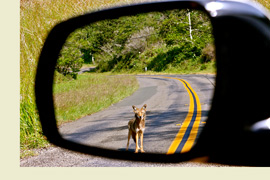 Native American folklore says that Coyote will outlive us all and be the last survivor on earth. But maybe not. In the chaos we create, we have also proven ourselves recklessly adaptable. In us, Coyote may have a companion. Native American folklore says that Coyote will outlive us all and be the last survivor on earth. But maybe not. In the chaos we create, we have also proven ourselves recklessly adaptable. In us, Coyote may have a companion.
Admiring him, hating him, killing him, in wonder of him.
In the meantime, like a provocative answer to a question we ask of the mirror, Coyote succeeds.
— Nathan
Callahan
|